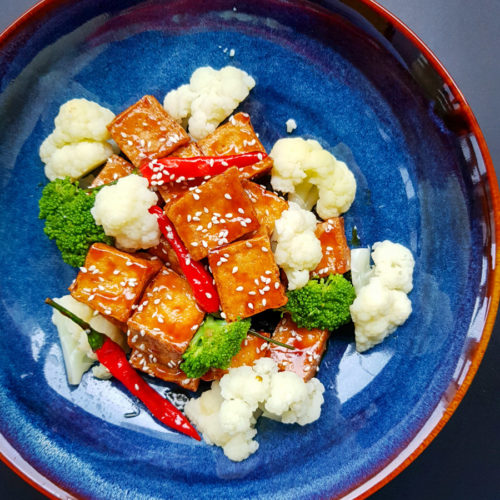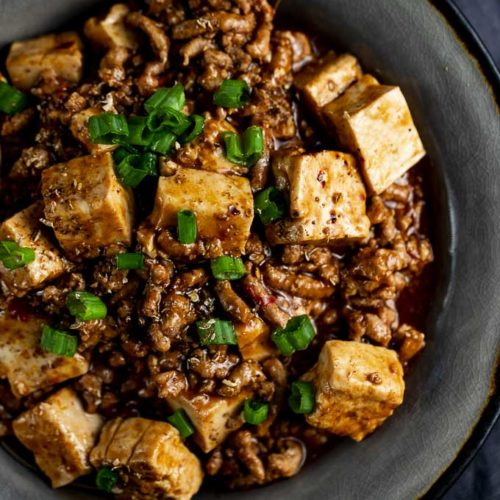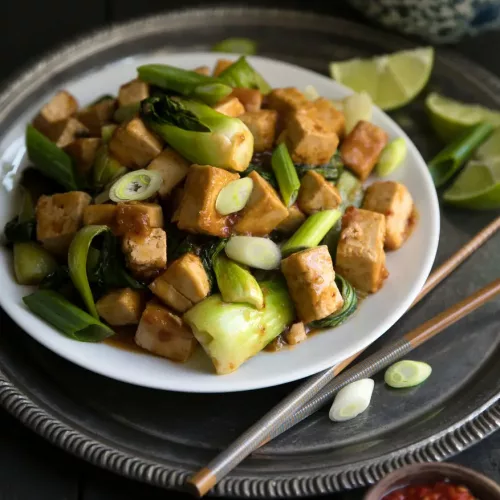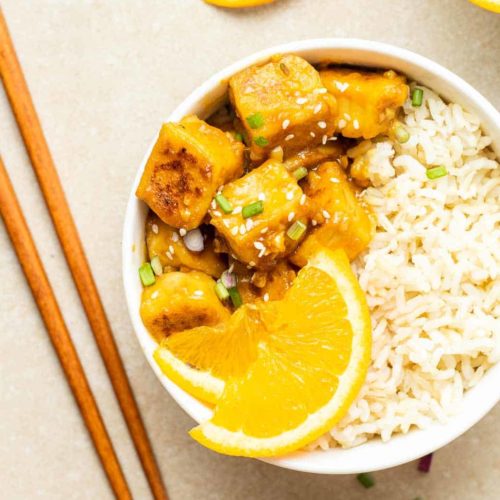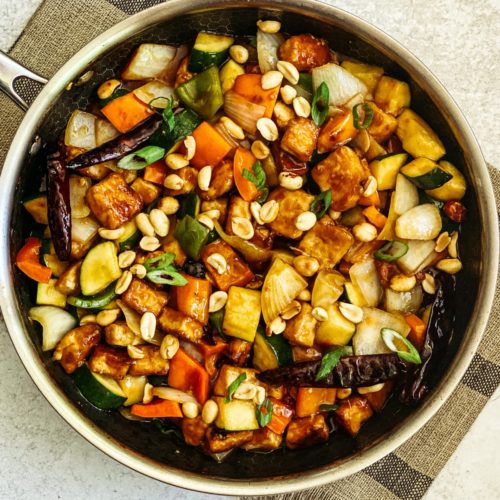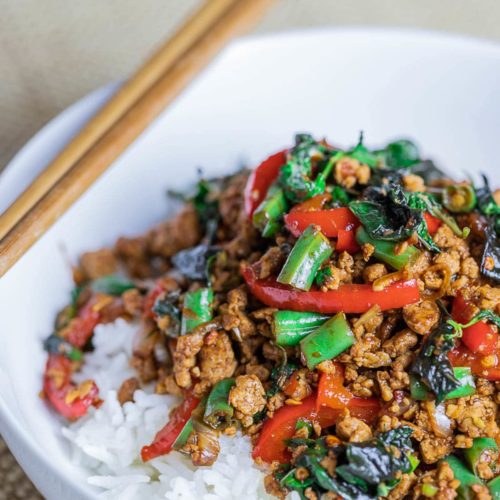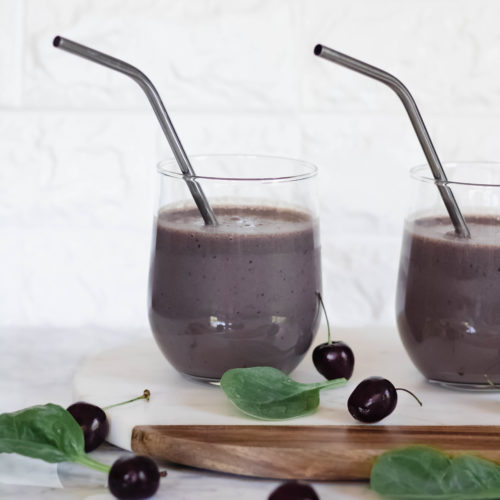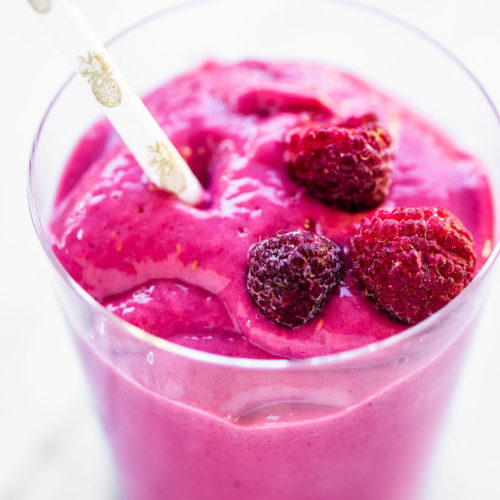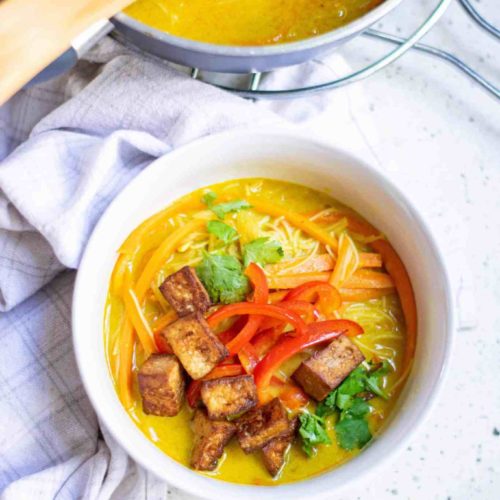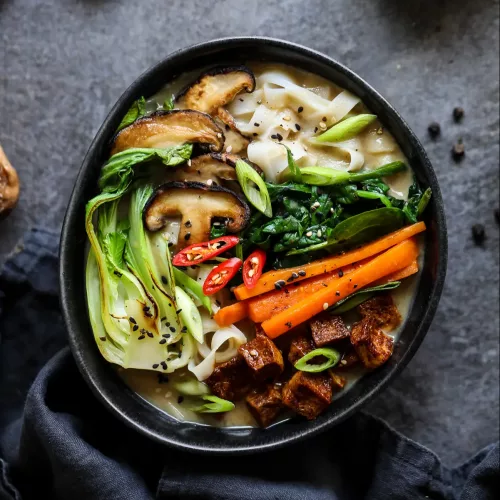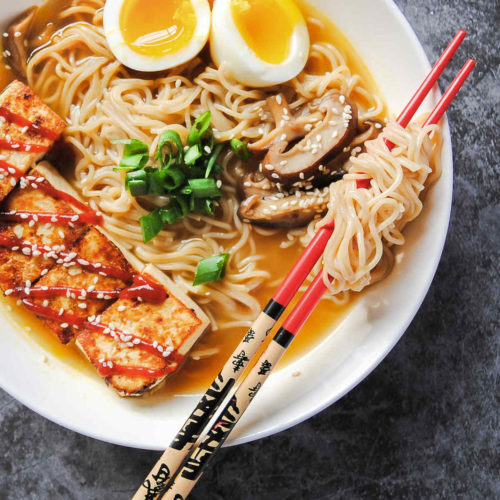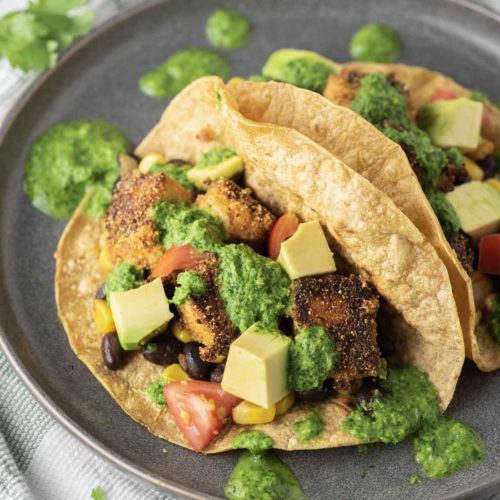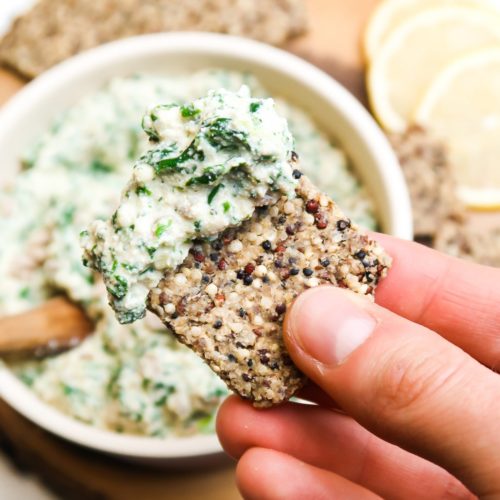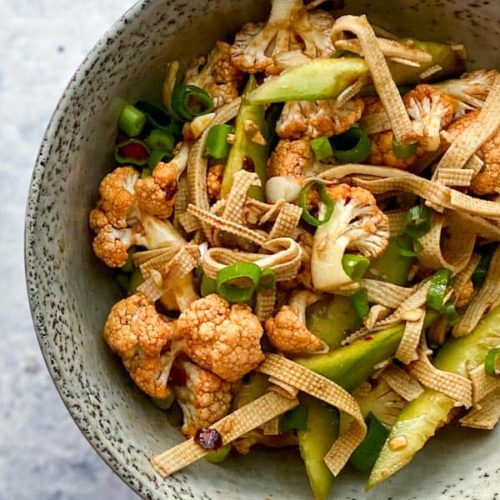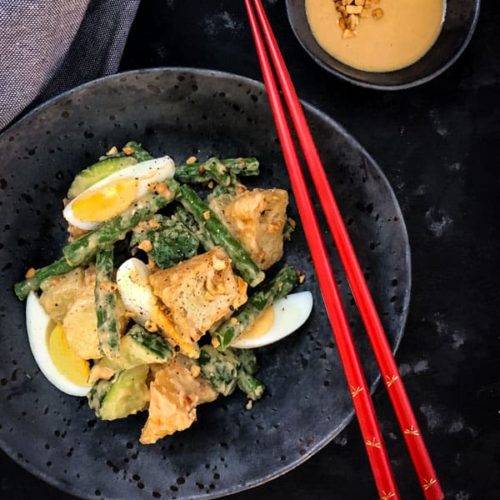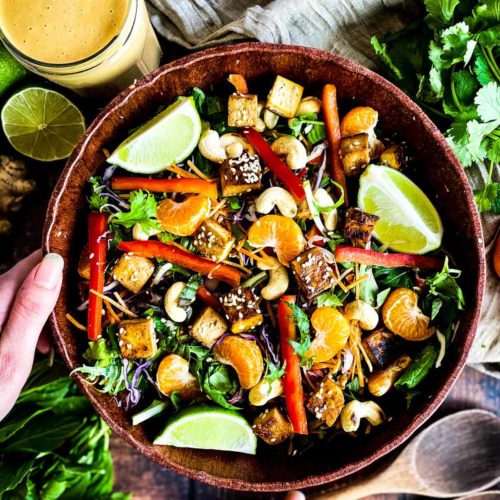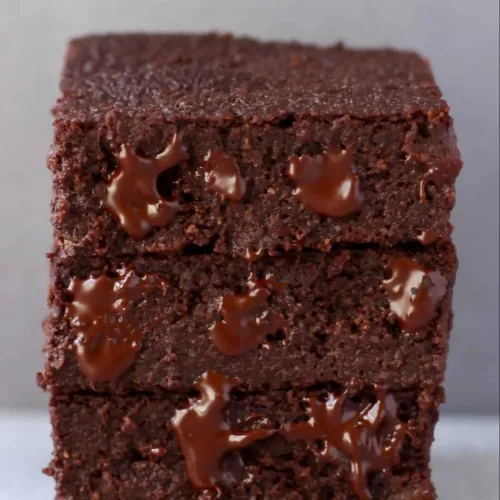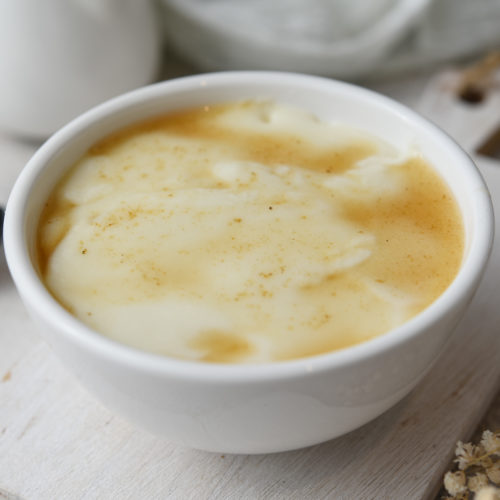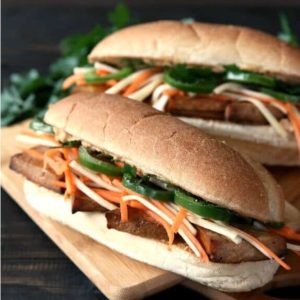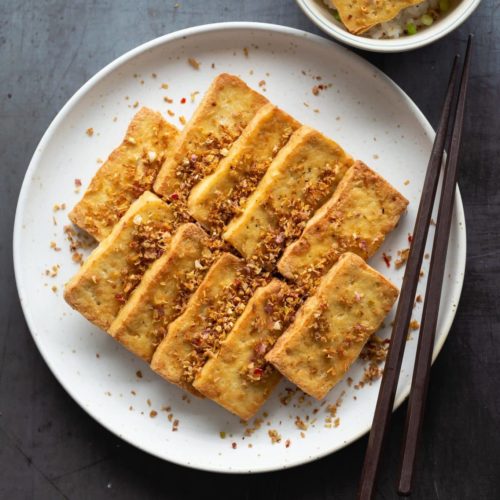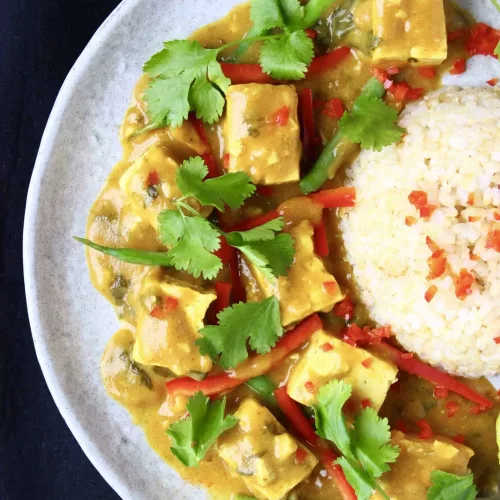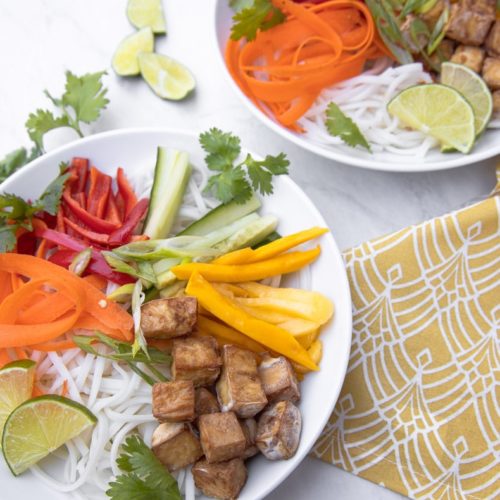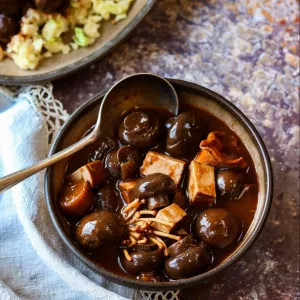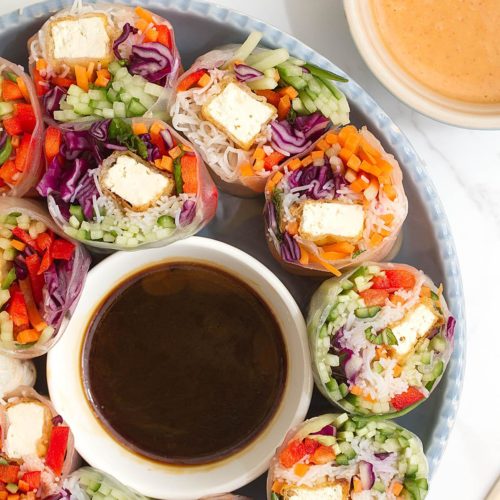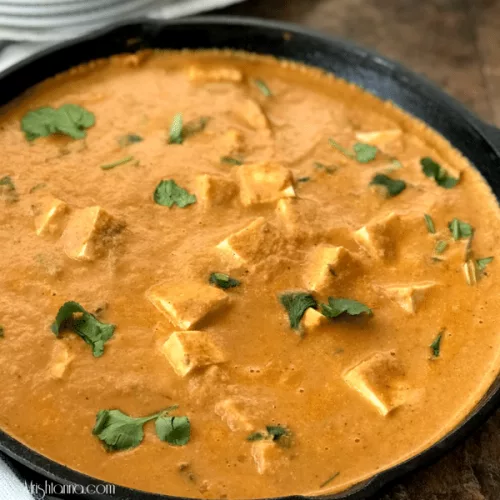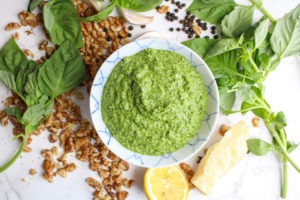Tofu is one of those foods that are extremely versatile and works well with any flavor profile. You can make savory meals such as stir fries, soups, and noodle dishes, while also making sweet desserts like cheesecake and smoothies. Because of its relatively bland flavor profile, tofu acts as a blank canvas for adding any flavors you want. In this guide of How to Cook Tofu for Beginners, I will go over the different ways you can cook tofu, 6 different sauce recipes you can make with tofu.
Table of Contents
How to Cook Tofu for Beginners:
4 Ways to Cook Tofu
Below, we will go over the different and most popular ways you can cook tofu. These methods are the most common ways to cook tofu. However, it’s not comprehensive. This guide will be a great start for any beginner. For each recipe below, I give the same simple recipe. The only difference, is the cooking method. Here is the simple ingredients list and starting instructions:
Ingredients:
- 1 block of medium, firm, or extra firm tofu, about 15 oz.
- 1 Tbs. oil ( I use avocado oil)
- Salt and pepper, to season
- 1 tsp. garlic powder (optional)
- 1 Tbs. cornstarch (optional)
Instructions:
- Open the package of tofu and drain all the liquid in the container into the sink.
- Put the wet block of tofu on a thick layer of paper towels. Then, getting more paper towels, press the dry paper towel on all sides of the block of tofu in order to extract as much moisture as possible.
- Then, cut the block into 1 inch cubes. For one block of tofu, I usually slice it 3×4 rows.
- Sprinkle freshly cracked pepper and sea salt on the tofu.
- Drizzle the tablespoon of oil and mix the tofu to combine all the seasonings.
- Take a 3-inch strainer and sift the cornstarch over the cubed tofu.
- Lastly, pick your method of cooking. Reference below to find the 3 cooking methods.
The cornstarch and garlic powder are optional ingredients. If you want your tofu crispy with more flavor, then add these two essential ingredients!
Pan-Fried Tofu

Pan-fried tofu will be the most common way to cook tofu, and arguably one of the least intimidating. Here’s a simple recipe and instructions:
Instructions:
- Pick off at step 7 from the main recipe above
- Heat a large skillet on high and place the cubed tofu in the pan, evenly spread out.
- Cook on each side of tofu for 5 minutes. I recommend using tongs for this, as it will be the easiest to turn over the tofu pieces.
- Serve it hot on plate with your favorite dipping sauce or dump straight into a curry or stir-fry.
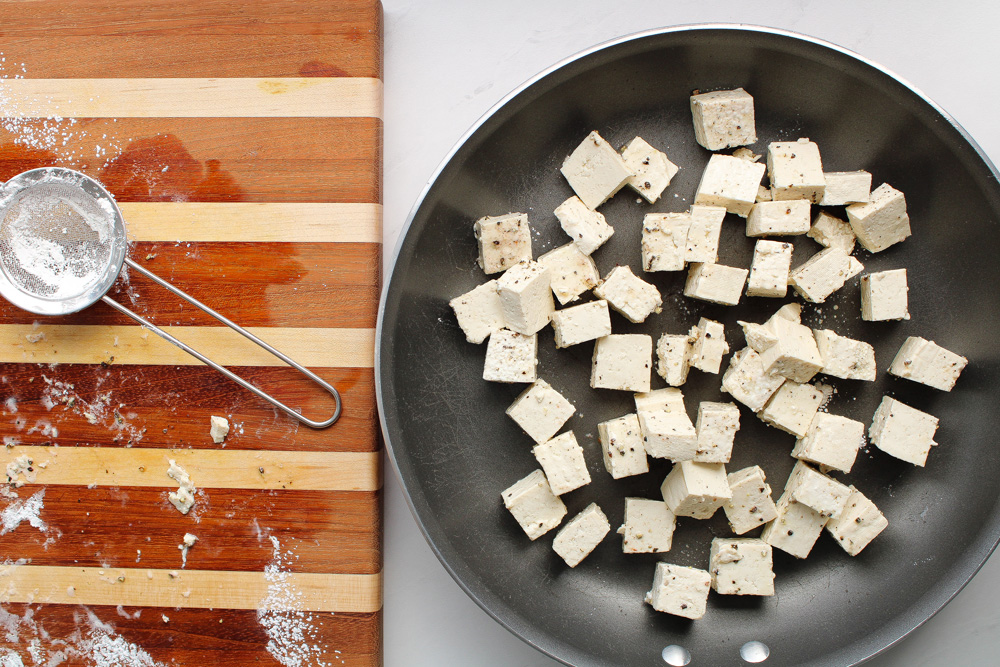
I recommend making pan-fried tofu when you don’t have a lot of cooking gadgets at your disposable. Maybe you don’t have an air fryer or you live in just a studio apartment without an oven. This will be the best method for you, and you will get easy, flavorful and crispy tofu.
Baked Tofu
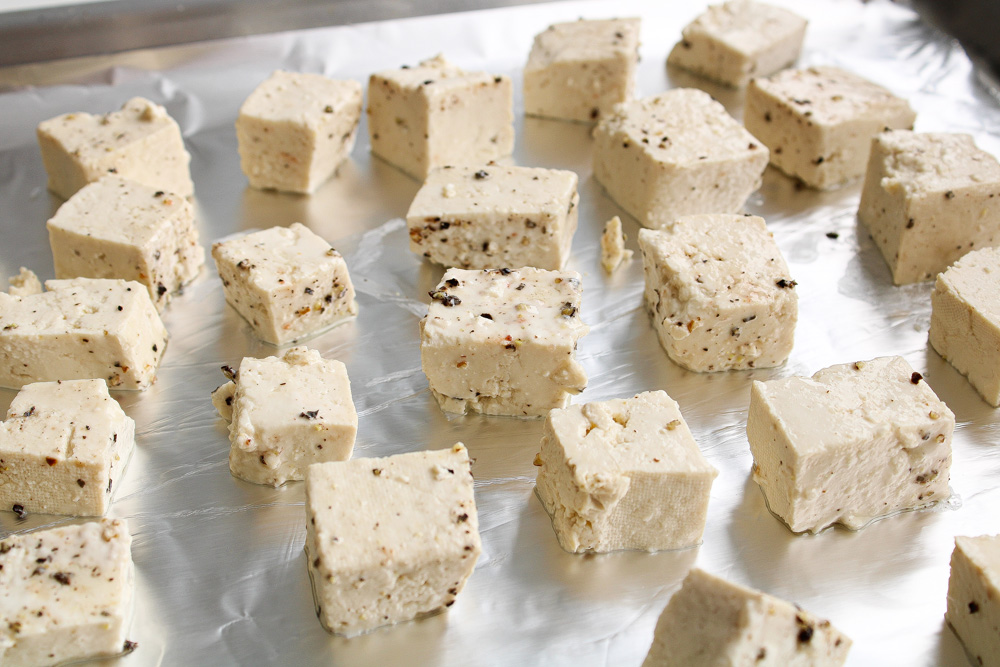
I really like baked tofu, more so than pan-fried. It takes longer to cook, but it’s also more hands-off than pan-frying tofu. Here are the instructions:
Instructions:
- Preheat the oven to 425°
- Line a baking sheet with foil or a silicon mat.
- Evenly space out the cubed tofu you prepared from the main recipe above.
- Once the oven is preheated, bake for 25-30 min.
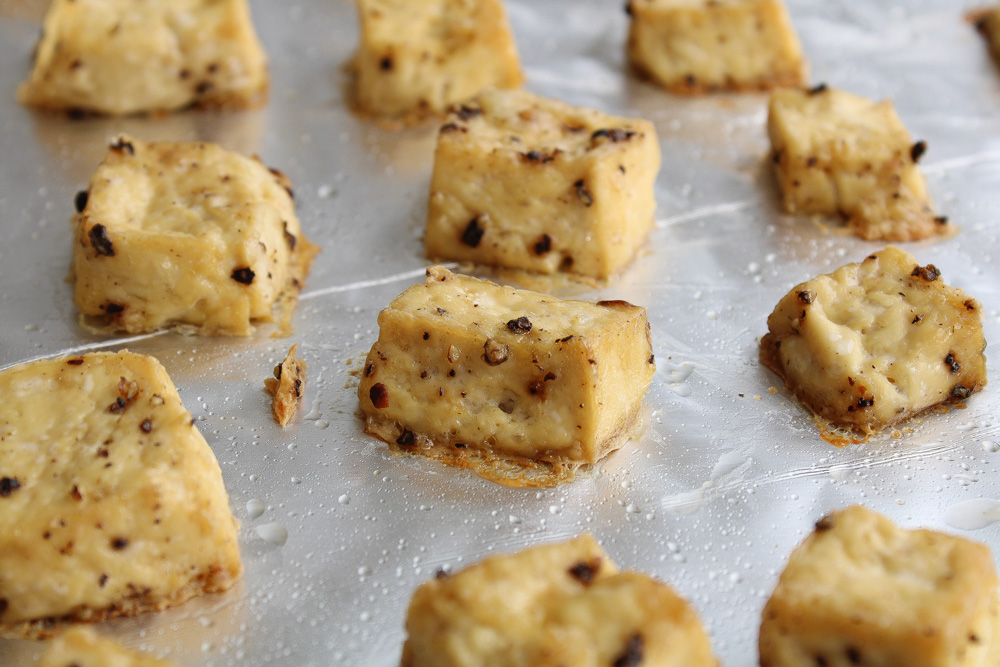
Baking tofu with cornstarch will make it really crispy, especially the bottom of the cubes. This is perfect if you want to simulate deep-fried tofu. If I don’t have access to my air-fryer, this is my go-to tofu cooking method.
Air-Fried Tofu

This method is by far my favorite. It takes the least amount of time for the crispiest tofu. You don’t even need to add cornstarch in order to mimic deep-fried tofu. Of course, cornstarch just makes it even crispier, but it’s really not essential, unlike in the other cooking methods. If you really wanted to, you can even omit the oil and it won’t drastically change the end-result, unlike the other cooking methods. Here are the instructions:
Instructions:
- Put the cubed tofu inside the air fryer, evenly spaced.
- Set the temperature for 360°F and cook for 15 minutes.
Scrambled Tofu
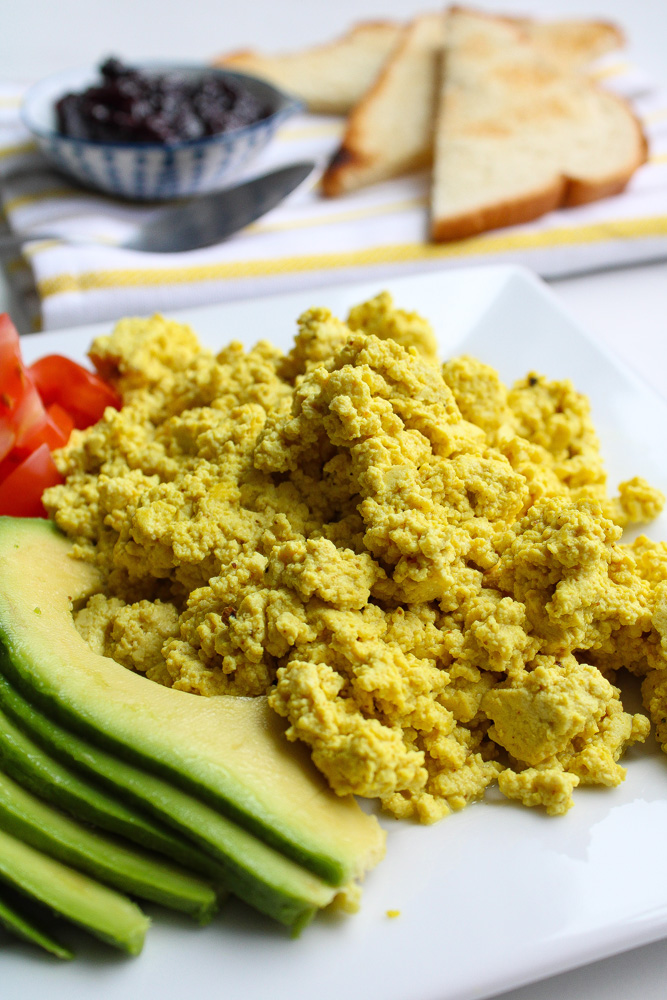
To be honest, scrambled tofu is very popular among vegans. That’s because this dish is commonly used as a substitute for classic scrambled eggs. I personally love this dish, because it surprisingly tastes like real scrambled eggs when done right. Plus, it’s an easy, quick dish that will help you eat more plat-based (if you’re into that, which I am). You can reference this classic alternative here. Below are the ingredients:
Ingredients:
- 2 blocks of firm tofu
- ½ tsp. turmeric
- ¼ tsp black salt
- ¼ c. nutritional yeast
- ¼ tsp garlic powder
- ½ tsp vegetable bullion
- ½ c water
6 Sauces and Marinades You Can Cook With Tofu
Now, you can eat the cooked tofu by itself no problem. However, sometimes adding a sauce always makes it better. For the six Asian-inspired sauces below, you can add them to the side of the tofu as a dipping sauce, or you can cook it together with the tofu in a pan for a simple stir-fry-like meal. Let’s start with the Teriyaki sauce!
1. Teriyaki Sauce
Teriyaki is perfect if you are wanting a sweet, garlicky, and ultimately savory and satisfying flavor. Here’s the sauce recipe:
Ingredients:
- ¾ cup soy sauce
- 1/3 c. brown sugar
- 10 cloves garlic, minced
- 2” knob ginger, grated
- 1 tbs. sesame oil
- 1 Tbs. Sambal
- ¼ tsp. ground white pepper
- 2 tsp. rice vinegar
- 1 Tbs. cornstarch
Instructions:
- Combine all the ingredients together in a small bowl (except the cornstarch) and whisk together until well combined.
- Heat a small saucepan on medium-high heat and pour the sauce mixture in and start stirring.
- Then gradually and slowly sprinkle in the cornstarch while you are constantly stirring the sauce mixture with a whisk (this will prevent clumps forming from the cornstarch).
- Then stir the sauce every 1-2 minutes for a total of 5 minutes or until the sauce thickens.
- Pour the sauce into a small dipping sauce dish and dip your crispy tofu in it for each flavor-packed bite.
- Or if you want the sauce completely covering the tofu, then pour the batch of crispy tofu into the small sauce pan and stir to combine. Serve with fresh rice.
If you like this sauce recipe and want to pair this with some other proteins, then check out my Easy Teriyaki Chicken.
2. Black Bean Sauce
Black bean sauce is great if you want a super savory, Unami packed sauce. Here’s the recipe:
Ingredients:
- 2 tbsp. black bean sauce
- 1 tbsp. soy sauce
- 1 tsp. oyster sauce
- 1 tsp. Asian vinegar or Saki
- 1 tsp. Hoisin sauce
- 1 Tbs. cornstarch
Instructions:
- Follow instructions for Teriyaki sauce written above.
3. Sweet and Sour Sauce
I used to obsess over this sauce in restaurants as a kid. This sauce is unique, as it’s not as salty as the other sauces, but much sweeter with the pineapple shining through.
Ingredients:
- 3 tbs. soy sauce
- 3 tbs. ketchup
- 3 tbs. Asian vinegar
- ¼ cup brown sugar
- ½ cup chicken broth
- ½ cup pineapple juice
- 1 tbsp. cornstarch
Instructions:
- Follow instructions for Teriyaki sauce written above.
4. Oyster Sauce
Oyster sauce is a classic, and is commonly found in stir fries like Chow Mein, Broccoli Beef, and others. If you use too much, your dish can become too fishy. However, this sauce has the perfect balance of oyster with other sauce ingredients including honey, soy sauce, and vinegar.
Ingredients:
- 2 tbs. oyster sauce
- 3 tbs. soy sauce
- 1 tbs. sambal
- 1 ½ tsp honey
- 1 ½ tsp rice vinegar
- 1 ½ tsp sesame oil
Instructions:
- Follow instructions for Teriyaki sauce written above.
5. Hoisin Sauce
Hoisin is another great sauce if you want something super Unami. You can buy Hoisin sauce at your local supermarket or Asian grocer. You can also buy a Vegetarian Hoisin if you don’t eat meat.
Ingredients:
- ½ cup soy sauce
- 4 tbs. Hoisin sauce
- 2 tsp. rice vinegar
- 2 tsp. honey
- 2 tbs. Sambal
- 1 tbs. cornstarch
Instructions:
- Follow instructions for Teriyaki sauce written above.
6. Kung Pao Sauce
Kung Pao can be an intimidating sauce to make. It seems complicated but with the right pantry ingredients, you can whip it up in no time.
Ingredients:
- ¼ cup Kung Pao sauce
- 2-3 tbs. Hoisin sauce
- 2 tbs. soy sauce
- 1 tbs. ketchup
- 1.5 tbs. Asian vegetable and fruit sauce
- 1 tbs. Asian vinegar
- 1 tsp. red chili pepper flakes or Chui Chow Chili Oil
Instructions:
- Follow instructions for Teriyaki sauce written above.
How to Cook Tofu for Beginners: What to Serve with Tofu
You can serve tofu with just about anything. One of my favorite side dishes to serve tofu with is rice and kimchi. I know that’s my inner Korean coming out. However, you can also put sautéed greens next to it, edamame, seaweed, Korean fried pancakes, and more. You can also serve tofu with a side of miso soup.
How to Handle Leftover Tofu
If you have raw, or uncooked tofu left over, then you can put it in air tight container with water and put it in the fridge. Just make sure to change out the water daily. You can also freeze the leftover tofu, which we will dive deeper into in the next section.
Can You Freeze Tofu?
Yes, you can freeze tofu! However, you have to keep in mind that tofu will take on new characteristics depending on what type it is. If you are freezing silken tofu, it will take on a chewier and firmer texture. It won’t be the same as when you first bought it. So, if you bought silken tofu for a very specific purpose, like making a sauce or smoothie, and you’re buying it for the texture, then don’t freeze it. If you want to change its texture or you don’t care, then you can freeze it. It ultimately depends on your preferences and what you want to cook.
There’s less of a noticeable change in medium, firm, and extra firm tofu besides its texture and firmness improving.
There is an advantage of freezing tofu. For any type of tofu you freeze, it will better soak up marinades. That’s because when water in the tofu freezes, then melts as it thaws, it drains out more quickly, creating more tiny air pockets. This makes a tofu with a greater spongy consistency. So, if you want to use a marinade for your next tofu dish, you might want to consider freezing it.
When freezing tofu, you can either cut it up into cubes and put it in an air-tight container and freeze or you can put the pre-packaged 15-oz blocks in the fridge. Then, when you want to use it, just take it out of the freezer and let it defrost in the fridge for 1-2 days.
How to Cook Tofu for Beginners: Tips to Make the Best Tofu
Pick the Right Texture to Suit Your Cooking Needs
This is so important, because there are so many varieties of tofu, it can be difficult to know which ones to cook with and for what dishes.
Overall, there are two types of tofu: Silken and regular. Silken tofu is a Japanese variety that is very smooth and tender in texture. It’s often used and blended in sauces, smoothies, dips, creams, baking recipes, and soups. It’s the creamiest type of tofu and is un-pressed. There’s different types of silken tofu. It’s labeled with different consistencies depending on how much soy protein is in it. You don’t want to press or fry silken tofu, as that could ruin it.
Regular Chinese tofu comes in a variety of consistencies ranging from soft to extra firm, depending on how much water has been pressed out of it. You will find this variety in the refrigerator section at your grocery store. Medium to firm tofu is usually more compact and has less water to it, because it’s been pressed more. Plus, you can press it even more when you take it home.
Chinese regular tofu is great for making stir fries, soups, snacks, and more.
That’s why it’s so important to briefly know the different kinds of tofu, so it can inform you on what kinds to use in the dishes you want to create. For example, you won’t want to make a stir fry with silken tofu. The end result will be a disaster and will end in a disintegrated tofu mash, because you were treating such a delicate food so harshly. Or, if you want to make a smoothie and you choose to use extra firm tofu…it might not turn out as creamy as you want.
Press It
Pressing your tofu is a major step. However, like mentioned before, you don’t want to press silken tofu or soft regular tofu. If you do, it will crumble apart. It’s best practice to press medium to firm tofu. Pressing tofu is as easy as getting some paper towels and pressing them to the tofu block until you can get most of the moisture out.
First, open the package of tofu and drain the water in the package. Lay your counter or a cutting board with a thick layer of paper towels and lay the block down. Get another thick layer of paper towels and press down on the top of the tofu blocks with the towels with your hands. You can also place the paper towels on top, and use a pan or textbook to place on top. This will add more pressure to the tofu and extract more water than just using your hands. Plus, if you stack a weight on top of the tofu, you can let it press for 5-10 minutes – a hands-off approach.
Then, after your press and dry the tops and sides of the block, cut the tofu block in half, length wise. This way you are exposing more moisture by slicing it right in the middle. After slicing it, flip each slice of tofu where the wetter side is face up. Then press it for another 5-10 minutes.
If you don’t have a lot of time on your hands, then just take the tofu block out of the container and press paper towels against the whole surface area of the block with your hands. This is what I do.
Now, you can buy tofu presses that will work quickly to get the water out. They can cost $10 – $30 on Amazon. However, I wouldn’t recommend buying one, unless you have extra money or kitchen space. I just don’t find them necessary when you can press the tofu with your hands or an old textbook.
Season and Flavor It
Tofu is a super bland food, so you not only need to season it, but you need to season it deliberately. Making sure you press tofu well and make sure you get out a lot of the moisture will also help the tofu soak up more flavor or seasonings.
When I press, cut, and season tofu, I season it once it’s dry, and before I add any oil to the tofu. This will allow the seasonings to stick more permanently on the tofu before adding slippery oil.
Other Ways to Use Tofu: 48 Recipes
Stir Fries
If this wasn’t clear before, tofu is great in stir fries. I think tofu is best used for stir fries, because it provides enough heartiness as a protein where you will get full and satisfied, but you’re not eating meat. Besides the sauce recipes I provided above, here are some more tofu stir fry recipes:
Chinese Sesame Tofu with Garlic Ginger Sauce
Spicy Chinese Mapo Tofu
Thai Basil Eggplant Stir Fry
Spicy Stir Fried Tofu with Bok Choy
Vegan Orange Chicken
Kung Pao Tofu
Thai Basil Tofu Stir Fry
Smoothies
Smoothies is an unconventional way to use tofu. However, use silken tofu when you added protein and a creamy texture to the smoothie. Below are some smoothie recipes using tofu:
High Protein Chocolate Smoothie
Tofu Fruit Smoothie
Soups
Soups is another great way to use tofu creatively. Use tofu for miso soups, sweet and sour soup, Korean Kimchi Stew, noodle soup, and more. Below are some recipes for tofu soup that can be useful to try.
Vegan Thai Coconut Soup with Crispy Tofu
Ramen with Rice Noodles and Tofu
Doenjang Jjigae Korean Bean Paste Soup
Vegan Thai Red Curry
Easy Vegetarian Tofu Ramen
Tacos
Yes, you can use tofu for tacos. After you press the tofu, break it into small pieces with your hands and season with salt, pepper, oil, and taco seasoning. Stir to combine. Heat a frying pan on high heat, and sauté until crispy and cooked through. Here are some tofu taco ideas and recipes:
Crispy Tofu Tacos
Wonton Tacos with Crispy Tofu
Mediterranean Crumbled Tofu Tacos
Dips and Cream Based Sauces
When you use silken tofu, you can make a variety of dips including ranch, herb and buffalo dips. You can also make cream based sauces using silken tofu including pasta sauces, Alfredo, and more. Here are some recipes:
Tofu Spread with Spelt Crackers
Vegan Spinach Dip
Salads
Adding tofu to your salads is one of the easiest ways to add protein to a dish that is easy to not make balanced. Follow these flavorful and creative recipes below to see how you can use tofu in salads.
Smoked Tofu and Sweet Potato Salad
Tofu Salad
Tofu Puff Salad with Snake Beans and Peanut Dressing
Vegan Tofu Katsu Salad
Thai Salad with Sesame Crusted Tofu
Desserts
You wouldn’t believe me if I said it, but you can make desserts with tofu. Chocolate desserts are especially popular with silken tofu. You can cakes, mousse, cream pies and more. Here are some recipes:
Vegan Chocolate Brownies
Instant Pot Tofu Pudding
Vegan Lemon Cheesecake
Simple Chocolate Protein Pudding
Berry and Chocolate Mousse Tart
Other Tofu Recipes
The reason I have “other” tofu recipes, is because the categories above do not do tofu justice when it comes to how you can use it. You can use tofu in such a variety of ways. The only limitation is your imagination. This list below will definitely prove it.
Vegan Banh Mi Sandwich with Spicy Tofu
Sofritas
Broccoli Tofu Quiche
Vegan Potato and Tofu Curry
Vegetable Tofu Ricotta Lasagna
Vegetable Bhuna
Vietnamese Lemongrass Chili Tofu
Peanut Tofu Satay Curry
Mango Spring Roll Bowl with Crispy Tofu
Vegan Mushroom Smoked Tofu Bourguignon
Vietnamese Summer Rolls
Crispy Air Fryer Tofu Nuggets
Tofu Butter Masala
Fun Facts About Tofu
Tofu is Over 2,000 Years Old
Tofu originated in China when a chef during the Han Dynasty (206 BC – 220 AD) accidentally curdled soy milk when he added nigari seaweed. There is also art that dates as far back as the Han Dynasty where it shows tofu production. How cool.
Tofu is Made Similar to Cheese
The process of making tofu is very similar to cheese. During the manufacturing process, coagulants are added to soy milk, so the solids separate from the liquids. Today, the coagulants people use is magnesium chloride, but nigari seaweed was the original coagulant used back in the day. Then the bean curds are packed into a press, formed into a block, and aged for a certain amount of time (depending on the type and firmness of the tofu).
Tofu is a Japanese Word
You may be wondering how Tofu is a Japanese word when it originated in China. However, it was introduced to Japan in the eighth century and took on a couple of different names, including “okabe”. It didn’t take on the name “tofu” until 1400. Tofu is a Japanese word that is derived from the Chinese (Mandarin) word “doufu”, which literally means curdled bean.
The Spread of Tofu Followed the Spread of Buddhism
Interestingly, the spread of tofu consumption throughout Japan and Korea was linked to Buddhism. Many Buddhists are vegetarian, because they believe that killing is linked to negative karma. Therefore, many avoid killing animals and eating meat. Back in the day, Buddhist priests were responsible for bringing tofu back to Japan.
Tofu was First Introduced in the U.S. by Benjamin Franklin
In 1770, Benjamin Franklin, one of our founding fathers, first introduced tofu in a letter to John Bartram. Ben Franklin actually encountered it while he was in London, and packaged a few soybeans up and referred to it as cheese from China. How interesting. Franklin also corresponded with James Flint on how the Chinese took soybeans and turned it into tofu. Flint writing “Towfu” in his letters to Ben Franklin was one of the first appearances of the word in the English language. The first tofu factory was erected in the United States in 1878.
Tofu Became Popular in the U.S. in 1971
Tofu didn’t become popularized until 1971 when Frances Moore Lappe published his book, Diet for a Small Planet. His book essentially proved the misconception that animal-based protein was superior false. He was one of the first people to introduce other forms of protein, like plant-based protein into America’s regular diet. His book was known at the time for diet and nutrition advice, and he talked a lot about the nutrition of tofu.

